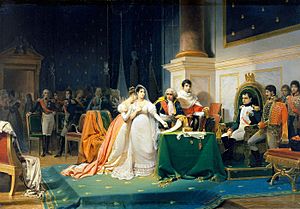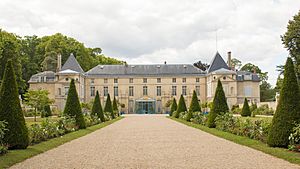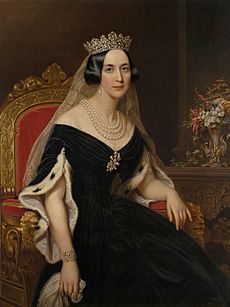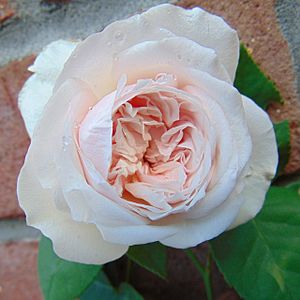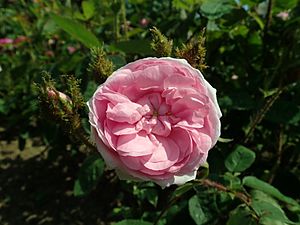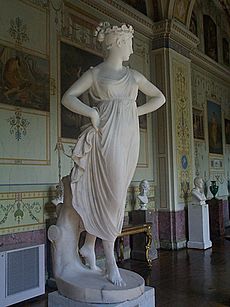Joséphine de Beauharnais facts for kids
Quick facts for kids Joséphine |
|||||
|---|---|---|---|---|---|
|
|||||
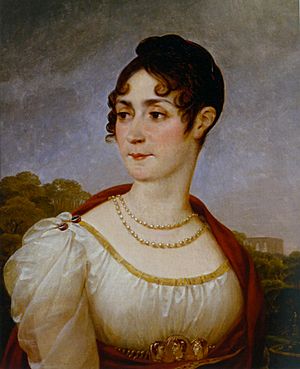
Portrait by Antoine-Jean Gros, c. 1809
|
|||||
| Empress consort of the French | |||||
| Tenure | 18 May 1804 – 10 January 1810 | ||||
| Coronation | 2 December 1804 | ||||
| Queen consort of Italy | |||||
| Tenure | 26 May 1805 – 10 January 1810 | ||||
| Born | Marie Josèphe Rose Tascher de La Pagerie 23 June 1763 Les Trois-Îlets, Martinique, French Antilles |
||||
| Died | 29 May 1814 (aged 50) Rueil-Malmaison, Kingdom of France |
||||
| Burial | Church of Saint-Pierre-Saint-Paul, Rueil-Malmaison, France | ||||
| Spouse |
Alexandre, Viscount of Beauharnais
(m. 1779; died 1794) |
||||
| Issue |
|
||||
|
|||||
| House | Tascher de La Pagerie | ||||
| Father | Joseph Gaspard Tascher de La Pagerie | ||||
| Mother | Rose Claire des Vergers de Sannois | ||||
| Religion | Roman Catholicism | ||||
| Signature |  |
||||
Joséphine Bonaparte (born Marie Josèphe Rose Tascher de La Pagerie; 23 June 1763 – 29 May 1814) was the first wife of Emperor Napoleon I. She became the Empress of the French on 18 May 1804. She was also Queen of Italy from 26 May 1805. Their marriage ended on 10 January 1810. She is also known as Joséphine de Beauharnais.
Joséphine's first husband, Alexandre de Beauharnais, died during a dangerous time in French history called the Reign of Terror. She was also held in prison for a short time. Through her children with Alexandre, she became the grandmother of French emperor Napoleon III. Her descendants also include members of today's royal families in Sweden, Denmark, Belgium, and Norway. She did not have children with Napoleon. Because of this, their marriage was ended, and Napoleon married Marie Louise of Austria. Napoleon wrote many love letters to Joséphine, and some of them still exist today.
Joséphine loved art and supported artists. She worked with sculptors, painters, and interior designers. She helped create a special style called the Consular and Empire style at her home, the Château de Malmaison. She collected many different kinds of art. Her Château de Malmaison was also famous for its beautiful rose garden, which she cared for deeply.
Contents
What's in a Name?
Joséphine is often called "Joséphine de Beauharnais." However, she never used this name herself. "Beauharnais" was the name of her first husband. She stopped using it when she married Napoleon. She then took the last name "Bonaparte."
Before meeting Napoleon, she was known as Rose or Marie-Rose Tascher de la Pagerie. Napoleon was the first to call her "Joséphine." This name might have come from her middle name, Josèphe. After marrying Napoleon, she became Joséphine Bonaparte. The name "Joséphine de Beauharnais" became popular later. This was during a time when people did not want to use Napoleon's name or her imperial title.
Where Was Joséphine Born?
There is some debate about where Joséphine was born. She was baptized in Les Trois-Îlets, Martinique. However, the church record only says she was baptized there, not born. Some people believe she was born on the island of Saint Lucia.
An old book from 1844 mentions people who were sure Joséphine was born in Saint Lucia. They said her family were early settlers there. They claimed she was born on a small estate called La Cauzette. Even Joséphine's enslaved nanny, Dede, said she nursed Joséphine at La Cauzette.
Joséphine's father owned an estate in Saint Lucia called Malmaison. This is the same name as her famous home in France. Saint Lucia changed hands many times between Britain and France. This might be why her birthplace was not clearly recorded.
Early Life and First Marriage
Childhood Years
Marie-Josèphe-Rose Tascher de La Pagerie was born in Les Trois-Îlets, Martinique. Her family was wealthy and owned a sugarcane plantation. This plantation is now a museum. Her family was an old French noble family. Her grandfather was the first to settle in Martinique in 1726.
Joséphine's father, Joseph-Gaspard, returned to Martinique after living in France. He married Rose-Claire des Vergers de Sannois. Joséphine was their first child. They had two more daughters, Catherine-Désirée and Marie-Françoise. Joséphine's father was a plantation owner and a military officer. He often struggled with money and health.
Joséphine was raised by an enslaved nurse named Marion. Joséphine later helped Marion gain her freedom in 1807. When she was ten, Joséphine and her sister Catherine-Désirée went to a boarding school. They learned reading, writing, singing, dancing, and embroidery. After Catherine-Désirée passed away, Joséphine returned home.
First Marriage Story
Joséphine's aunt was connected to a wealthy noble family, the Beauharnais. Her aunt thought it would be good if her nephew, Alexandre de Beauharnais, married one of her nieces. Alexandre was 17, and Joséphine was 15. He first chose Joséphine's younger sister, Catherine-Désirée. Her father was poor, and Alexandre was rich, so no dowry was asked for.
However, Catherine-Désirée died before the marriage could happen. Joséphine's father then offered his youngest daughter, Marie-Françoise. But she was too young, not yet twelve. So, Joséphine became engaged to Alexandre instead.
In October 1779, Joséphine traveled to France with her father. She married Alexandre on 13 December 1779. They had two children: a son, Eugène de Beauharnais, and a daughter, Hortense de Beauharnais. Hortense later married Napoleon's brother, Louis Bonaparte. Joséphine and Alexandre's marriage was not happy. Alexandre left his family for over a year. A court ordered them to live separately, with Alexandre paying for Joséphine and the children.
During the French Revolution
On 2 March 1794, during a dangerous period called the Reign of Terror, Joséphine's husband was arrested. He was put in the Carmes prison in Paris. Joséphine was also arrested on 18 April 1794. She was imprisoned in the same prison until 28 July. During this time, she could only send messages to her children on laundry lists.
Her husband was accused of not defending a city well. He was seen as an enemy of the revolution. He was sentenced to death and executed on 23 July 1794. Joséphine was freed five days later. This was because the leader of the Reign of Terror, Robespierre, was also executed, ending that dangerous time. In June 1795, a new law allowed Joséphine to get back her husband's possessions.
Marriage to Napoleon
After her first husband's death, Joséphine met Napoleon Bonaparte. He was six years younger than her. In January 1796, Napoleon proposed to her. They married on 9 March. On their marriage certificate, Joséphine made herself seem four years younger. She also made Napoleon seem 18 months older. This made them appear closer in age. Before meeting Napoleon, she was known as Rose. But Napoleon preferred to call her Joséphine, and she used that name from then on.
Napoleon's family did not like the marriage. They were surprised he married an older widow with two children. His mother and sisters felt uncomfortable around Joséphine. Two days after the wedding, Napoleon left Paris to lead the French army in Italy. While they were apart, he sent her many loving letters. He wrote about how much he loved her. Joséphine, however, did not write back as often, and her letters were not as warm. It took her years to truly love Napoleon as much as he loved her. Napoleon was said to carry her picture and kiss it often.
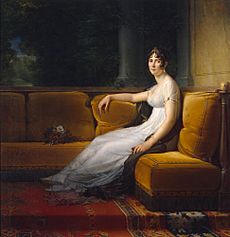
In 1796, Joséphine started a relationship with a handsome officer named Hippolyte Charles. Napoleon heard about this and was very angry. His feelings for her changed a lot after that.
In 1798, Napoleon led a French army to Egypt. During this time, Napoleon also had a relationship with another woman. After this, Joséphine and Napoleon's relationship was never the same. His letters became less loving.
In December 1800, Joséphine was almost killed. Someone tried to assassinate Napoleon by planting a bomb. On 24 December, Joséphine and Napoleon were going to the opera. They were in two carriages. Joséphine was in the second carriage with her daughter, Hortense, and other family members. Joséphine had delayed the group while getting a new shawl. Napoleon went ahead in the first carriage. The bomb exploded as her carriage passed. It killed several people and a horse. The carriage windows shattered, and Hortense was hit by glass. Luckily, no one else was seriously hurt, and they continued to the opera.
Empress of the French
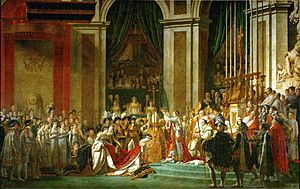
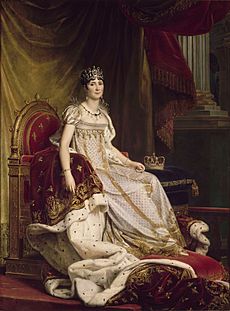
Napoleon became Emperor of the French in 1804. This made Joséphine the empress. Their coronation ceremony was held at Notre-Dame de Paris on December 2. The Pope was there, but Napoleon crowned himself first. Then, he placed the crown on Joséphine's head, making her empress. This showed that he, not the church, held the power in Europe.
As empress, Joséphine had a royal court. She had many ladies-in-waiting and staff. Shortly before their coronation, there was a disagreement between Joséphine and Napoleon. It almost ended their marriage. Joséphine found Napoleon with one of her ladies-in-waiting. Napoleon threatened to divorce her because she had not had a child. But with help from her daughter Hortense, they made up.
After a few years, it became clear Joséphine could not have a child. Napoleon still loved her, but he needed an heir for France. His nephew, who was supposed to be his heir, died in 1807. This made Napoleon think seriously about ending his marriage. On 30 November 1809, he told Joséphine he needed to find a wife who could have children for France. Joséphine agreed to the divorce so the Emperor could remarry. The divorce ceremony took place on 10 January 1810. It was a formal but sad event. Both Joséphine and Napoleon read statements saying they cared for each other.
On 11 March, Napoleon married Marie-Louise of Austria. The formal ceremony was in April. Napoleon once said that he was marrying Marie-Louise for her ability to have children. Even after their separation, Napoleon insisted Joséphine keep her title as empress. He said she should always know he was her best and dearest friend.
Later Life and Death

After the divorce, Joséphine lived at the Château de Malmaison, near Paris. She remained good friends with Napoleon. He once joked that her debts were the only thing that came between them. In April 1810, Napoleon made her the Duchess of Navarre. Some people believe Napoleon and Joséphine were still secretly in love.
In March 1811, Marie Louise gave birth to a son, Napoleon II. He was given the title "King of Rome." Two years later, Napoleon arranged for Joséphine to meet the young prince.
Death
Joséphine died from pneumonia on 29 May 1814. She was at her home, Rueil-Malmaison. She had recently walked with Emperor Alexander I of Russia in her gardens. She was buried in the nearby church of Saint Pierre-Saint Paul in Rueil. Her daughter Hortense is buried next to her.
Napoleon learned of her death while he was in exile on Elba. He stayed in his room for two days, refusing to see anyone. He later told a friend that he truly loved Joséphine but did not respect her. Despite their divorce and his remarriage, Napoleon's last words on his deathbed were: "France, the Army, the Head of the Army, Joséphine."
Joséphine's Descendants
Joséphine's daughter, Hortense's son, Napoleon III, later became Emperor of the French. Her son, Eugène's son, Maximilian, married into the Russian Imperial family. Eugène's daughter, Joséphine, married King Oscar I of Sweden. He was the son of Napoleon's former fiancée. Through this Joséphine, Joséphine Bonaparte is a direct ancestor of today's royal families. These include the royal houses of Belgium, Denmark, Luxembourg, Norway, and Sweden.
Many jewels worn by modern royals are said to have belonged to Joséphine. The Norwegian royal family owns an emerald and diamond set that is believed to be hers. The Swedish royal family has several pieces linked to Joséphine. These include the Leuchtenberg Sapphire Parure, amethyst jewels, and the Cameo Parure. This cameo set is worn by Sweden's royal brides. However, some of these jewels might have belonged to other family members, not Joséphine herself.
Another of Eugène's daughters, Amélie of Leuchtenberg, married Emperor Pedro I of Brazil. She became Empress of Brazil. They had one daughter, Princess Maria Amélia.
Personality and Appearance
Joséphine was known for being kind, generous, and charming. She was a wonderful hostess. She was also known for spending a lot of money. She was described as being of average height and slender. She had long, chestnut-brown hair and hazel eyes. Her nose was small and straight, and her mouth was well-shaped. She often kept her mouth closed because she had bad teeth. People admired her elegance, style, and her soft, "silvery" voice.
Patroness of Roses
In 1799, Joséphine bought the Chateau de Malmaison. She designed its gardens in an "English" style. She hired gardeners and plant experts from the United Kingdom. These included Thomas Blaikie and Alexander Howatson. She also worked with botanist Ventenat and horticulturist Andre Dupont. The rose garden started soon after she bought the house. Joséphine took a personal interest in the gardens and the roses. She learned a lot about plants from her staff.
Joséphine wanted to collect every known type of rose. Napoleon even ordered his warship commanders to search captured ships for plants to send to Malmaison. Pierre-Joseph Redouté was hired to paint the flowers from her gardens. His book Les Roses was published later. It showed 168 plates of roses, and many of them grew at Malmaison. Even though England and France were at war, rose shipments were allowed to cross blockades for Joséphine's garden. Sir Joseph Banks, a famous botanist, also sent her roses.
It is believed she had about 250 roses in her garden when she died in 1814. She created the first written history of growing roses. She is also thought to have hosted the first rose exhibition in 1810.
Modern rose breeding, where new roses are created by carefully mixing different types, began with Joséphine's gardener, Andre Dupont. Before this, most new roses appeared by chance. With Dupont's method, many new types of roses appeared. Of the about 200 types of roses Joséphine knew, Dupont created 25 while working for her. In the 30 years after Joséphine's death, French breeders created over 1000 new rose types. By 1910, there were about 8000 types of roses. Joséphine's love for roses helped make them popular garden plants. People copied her because she was a popular and fashionable ruler.
After Joséphine died in 1814, her house was empty at times. The garden and house were damaged. The garden's remaining plants were destroyed in a battle in 1870.
A rose called Impératrice Joséphine was named after her before 1815. Another rose, Joséphine Beauharnais, was named in her honor in 1823. The famous rose 'Souvenir de la Malmaison' appeared in 1844. It was named after her 30 years after her death.
Art Patronage
Empress Joséphine loved all forms of art. She was very interested in gardening, but she also loved paintings, sculptures, and furniture. She surrounded herself with creative people. Joséphine's interest in art grew after her first marriage. Her husband's high social position allowed her to visit many influential homes. There, she learned about different artworks. After marrying Napoleon and becoming Empress, she was surrounded by the art of her time. She also liked older artworks. She looked for artists and styles that were not common then. She visited art shows to connect with modern artists. Joséphine supported many artists, helping them become famous.
After buying the Château de Malmaison, Joséphine had a perfect place to show her art and style. She created art rooms, galleries, a theater, and her famous garden. Malmaison and the Tuileries Palace became important centers for art in Europe. Joséphine's court became a leading place for the arts. She was the first French female royal to collect art on such a large scale. She led the way in the Consular and Empire Style.
Paintings
Joséphine worked with and collected art from many painters. She was painted by artists like Jacques-Louis David and Francois Gerard. However, she especially liked and often commissioned Antoine-Jean Gros. Gros heard Joséphine would visit Genoa. He worked to meet her, knowing that a connection with Joséphine would make him famous.
When Joséphine met Gros and saw his work, she asked him to come to Milan with her. She wanted him to live in her homes. Joséphine then asked him to paint a portrait of her husband, Napoleon. This painting took several sittings. It was named "General Bonaparte at the Bridge of Arcole, November 17th, 1796." This painting became a big part of Napoleon's public image. Gros painted other portraits of Napoleon, always showing him as a strong conqueror. Joséphine supported Gros, helping him spread the government's message about the Emperor's power.
Sculpture
Joséphine commissioned four major sculptures from the Italian artist Antonio Canova. The Empress received a copy of Canova's work Psyche and Cupid. She then asked Canova to create a new sculpture. The result was Dancer with Hands on Hips. This work was ordered in 1802 but finished in 1812. Joséphine allowed him to create it in his own style. It was based on classical art but looked more relaxed and joyful. Canova made several sculptures of dancers. Dancer with Hands on Hips was praised because it was original, not a copy of an old sculpture.
Joséphine asked Canova for another sculpture called Paris. The plaster model was done in 1807. The marble statue was finished in 1812 and arrived at Malmaison in 1813. This was a year before Joséphine died. The last sculpture she commissioned was The Three Graces. This work was not finished until 1816, after Joséphine's death. All four of these sculptures were later sold to Tsar Alexander of Russia.
Furniture and Design
The architects Charles Percier and Pierre Fontaine became the main decorators for Joséphine and Napoleon. Many of Joséphine's famous furniture pieces were made especially for her by Percier and Fontaine. These architects worked in many of the Empire's royal homes. They created spaces where the Empress felt at home. Percier and Fontaine had their own unique style. Their pieces for the Emperor and Empress are easy to recognize. They were known for using cheval glass (a type of mirror) and creating a soft, feminine feel for Joséphine's private rooms. These pieces were unique and admired for their creativity. Percier and Fontaine are linked to the Empire style of that time.
Arms
 Empress of the French (1804–1809) |
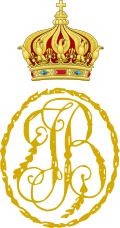 Monogram of the Empress of the French (1804–1809) |
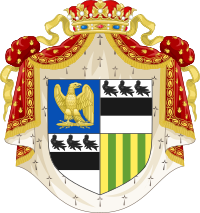 Duchess of Navarre (1810–1814) |
See also
 In Spanish: Josefina de Beauharnais para niños
In Spanish: Josefina de Beauharnais para niños



